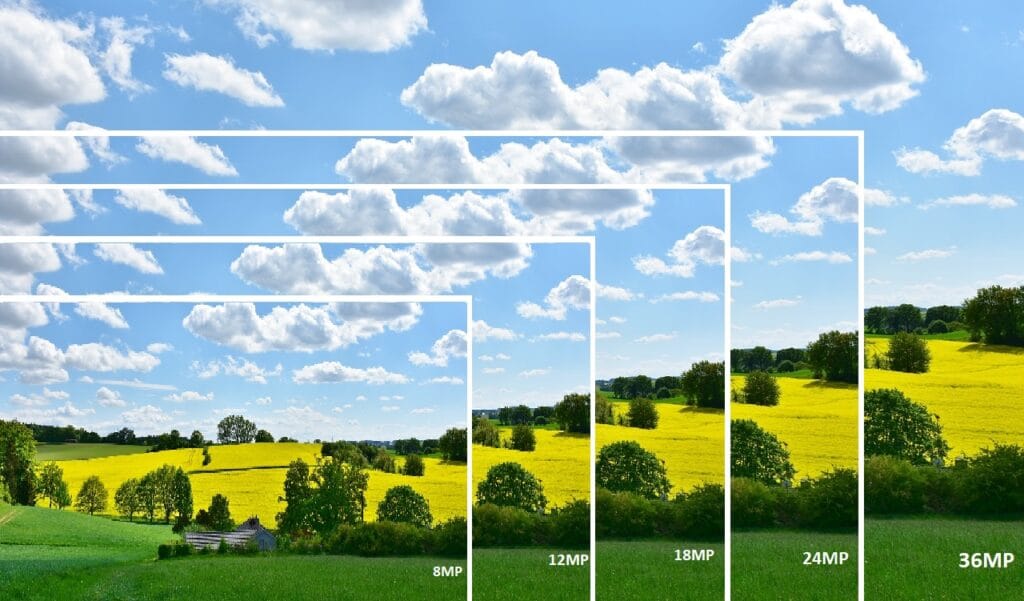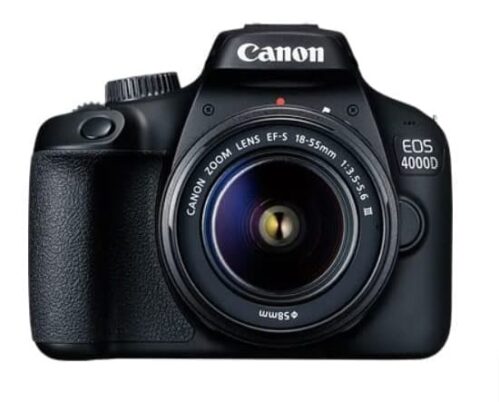If you’re looking to buy a DSLR camera, you’ll want to consider several factors to ensure that you get the best camera for your needs. Here are some key considerations to keep in mind when buying a DSLR camera:
Budget
DSLR cameras can range in price from a few hundred to several thousand dollars. Set a budget that you’re comfortable with, but keep in mind that you’ll also need to purchase lenses, memory cards, and other accessories.
Entry-level DSLR cameras: These cameras are designed for beginners and can range from around £400 to £700. Examples of entry-level DSLR cameras include the Canon EOS Rebel T7 and the Nikon D3500.
Mid-range DSLR cameras: These cameras offer more advanced features and typically cost between £800 and £1500. Examples of mid-range DSLR cameras include the Canon EOS 90D and the Nikon D7500.
Professional DSLR cameras: These cameras are designed for professional photographers and can cost anywhere from £1500 to over £6000. Examples of professional DSLR cameras include the Canon EOS 1DX Mark III and the Nikon D6.
It’s important to note that these prices only reflect the cost of the camera body and do not include the cost of lenses and other accessories that you may need. Lenses can range in price from a few hundred dollars to several thousand dollars depending on the brand and quality.
Megapixels:
The number of megapixels doesn’t necessarily equate to better image quality, but it can impact the size of the photos you can print. If you plan on printing large prints, you may want a camera with a higher megapixel count.

The number of megapixels that is “enough” really depends on your specific needs and how you plan to use your photos. Generally speaking, for most everyday photography purposes such as sharing on social media or printing photos up to 8×10 inches, a camera with 12-16 megapixels is sufficient.
However, if you plan to crop your photos heavily, print them at large sizes, or want to retain maximum detail and resolution, a camera with higher megapixels (20 megapixels or more) may be more suitable.
It’s important to note that megapixels are just one factor in determining the overall image quality of a camera, and a higher megapixel count does not necessarily mean better image quality. Other factors such as the sensor size, ISO range, and lens quality can also have a significant impact on image quality.
Sensor Size:
The size of the sensor in a camera can have a significant impact on image quality. A larger sensor generally has larger pixels, which are able to capture more light and provide better low-light performance, greater dynamic range, and improved image quality with less noise or grain in the image.
A larger sensor also allows for shallower depth of field, which can be desirable for portrait and product photography where you want to blur the background and focus on the subject.
The most common sensor sizes in DSLR cameras are APS-C and full-frame. APS-C sensors are smaller and generally found in entry-level and mid-range DSLR cameras, while full-frame sensors are larger and found in higher-end and professional DSLR cameras.
In general, full-frame sensors provide better image quality and performance, but they also come with a higher price tag. However, APS-C sensors can still produce excellent image quality, and may be a more affordable option for those on a budget or just starting out in photography.
ISO Range:
The ISO range determines how sensitive the camera is to light. A higher ISO range can be useful for low-light situations, but it can also introduce noise into your images.
The ISO range is an important factor to consider when choosing a DSLR camera. ISO determines how sensitive the camera’s sensor is to light, and a higher ISO allows you to capture images in low-light conditions without having to use a flash or slower shutter speed.
However, as the ISO is increased, the image quality can degrade due to an increase in digital noise or grain in the image. A camera with a wider ISO range can offer more flexibility in various lighting situations, but it’s important to note that higher-end DSLRs can produce images with less noise at high ISO settings compared to entry-level models.
In general, professional-level DSLR cameras offer wider ISO ranges, and can produce clean images even at higher ISO settings. However, for most everyday photography purposes, a camera with an ISO range of 100-6400 should suffice.
It’s also worth noting that image stabilization technology has advanced, allowing many newer camera models to produce better low-light results, even at lower ISO settings, so the ISO range should be considered in context with the camera’s other features and capabilities.
Lens Mount:
The lens mount type is an important factor to consider when choosing a DSLR camera. The lens mount determines which lenses are compatible with the camera body, and the availability of compatible lenses can have a significant impact on the flexibility and versatility of your photography.
Most DSLR cameras have proprietary lens mounts specific to the brand, so if you already have a collection of lenses from a particular brand, it’s usually best to stick with that brand when purchasing a new camera. For example, Canon DSLRs use the Canon EF lens mount, while Nikon DSLRs use the Nikon F mount.
It’s also important to consider the availability and variety of lenses available for your camera’s mount. Popular brands like Canon and Nikon have a wide selection of lenses available for their cameras, including a range of budget-friendly options and high-end professional lenses.
Additionally, third-party lens manufacturers like Sigma, Tamron, and Tokina also make lenses that are compatible with multiple camera brands, so you may want to consider these options as well.
Overall, the lens mount type is an important factor to consider when choosing a DSLR camera, as it can impact the lenses you’re able to use and the versatility of your photography.
Autofocus:
Consider the autofocus system of the camera. Some cameras have faster and more accurate autofocus systems than others, which can be particularly useful for action or sports photography.
Whether or not you need an autofocus (AF) camera depends on your personal preferences and the type of photography you plan to do.
If you’re planning to shoot action, sports, or wildlife photography, then an AF camera can be very useful as it allows you to track and capture moving subjects quickly and accurately. Similarly, if you plan to shoot in low light conditions, an AF camera can be beneficial as it can help you to focus more accurately and quickly in these situations.
On the other hand, if you’re planning to shoot still-life, landscapes, or portraits, then an AF camera may be less important as these types of photography tend to involve less movement and may be better suited to manual focus. Additionally, some photographers prefer manual focus for creative control over the focus and depth of field in their images.
It’s worth noting that many modern DSLR cameras have both autofocus and manual focus capabilities, so you can switch between the two depending on your needs. So, whether or not you need an AF camera ultimately depends on your personal preferences and the type of photography you plan to do.
Video Recording:
If you plan on using your camera for video recording, make sure to look for a camera that offers good video capabilities, such as high-resolution video, manual controls, and microphone input.
If you’re primarily interested in photography and don’t plan on shooting video, then video recording may not be a priority for you. However, if you’re interested in videography or plan to use your camera for both photography and video, then video recording capabilities may be an important factor to consider.
If you do plan on shooting video, there are several factors to consider, such as video resolution, frame rate, and video quality. A camera with 1080p or 4K video resolution, higher frame rates, and good video quality can help you produce high-quality video content.
It’s also worth noting that DSLR cameras with video capabilities often offer additional features that can be useful for video, such as manual control over exposure, focus, and audio recording. These features can give you more control over your videos and allow you to create more professional-looking content.
Brand Reputation:
Brands do matter when it comes to choosing a DSLR camera. Different camera brands have their own strengths and weaknesses, and each brand offers a unique set of features, lenses, and accessories.
Some popular DSLR camera brands include Canon, Nikon, Sony, and Fujifilm, among others. Canon and Nikon are two of the most popular and well-established camera brands, with a wide range of camera bodies, lenses, and accessories available. Sony is also a popular choice, particularly for mirrorless cameras, which are smaller and lighter than traditional DSLRs.
When considering a camera brand, it’s important to think about the types of photography you plan to do and the features and lenses that will be most useful to you. Different brands may offer unique features that are particularly useful for certain types of photography, such as sports or wildlife photography.
Additionally, it’s important to consider the availability and cost of lenses and accessories for your chosen brand. Some camera brands have a wider selection of lenses and accessories than others, which can impact your ability to find the right gear for your needs.
Overall, the brand of a DSLR camera is an important factor to consider when making your purchase, as it can impact the camera’s features, lens selection, and compatibility with other gear.
Size and Weight:
The best size and weight for a DSLR camera depends on your personal preferences and the type of photography you plan to do.
For some photographers, a larger camera body with a comfortable grip and plenty of physical controls can be important for ease of use and control. This may be particularly true for photographers who shoot for extended periods or with larger lenses. However, for photographers who prioritize portability and mobility, a smaller, lighter camera body may be more desirable.
It’s also worth considering the size and weight of any lenses you plan to use with your camera. Larger and heavier lenses can be more difficult to carry and use for extended periods, so you may want to consider a camera body that balances well with the lenses you plan to use.
Ultimately, the best size and weight for a DSLR camera is subjective and depends on your individual needs and preferences. It’s a good idea to try out different camera bodies in person to get a sense of their size and weight and how they feel in your hands.
User Interface:
the user interface (UI) of a DSLR camera is an important factor to consider when making a purchase. The UI determines how easy and intuitive it is to access and adjust camera settings, navigate menus, and review and manage images.
A well-designed UI can make it easier and more efficient to use the camera, allowing you to focus more on your photography and less on navigating complex menus and settings. It can also help you to quickly adjust settings on the fly, which can be particularly important when shooting in fast-paced environments or changing lighting conditions.
In addition to the UI, it’s also worth considering the display and controls of the camera. A high-quality display with good resolution and color accuracy can help you to review and assess your images more accurately. Similarly, well-placed physical controls and buttons can make it easier to quickly adjust settings without having to navigate through menus.
Overall, the UI and design of a DSLR camera are important factors to consider when making a purchase, as they can impact your ability to use the camera effectively and efficiently. It’s a good idea to research and compare the UI and controls of different camera models before making a final decision.







